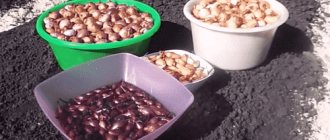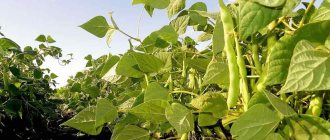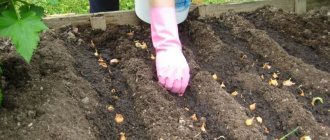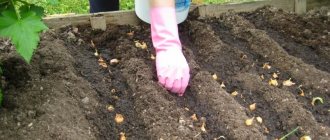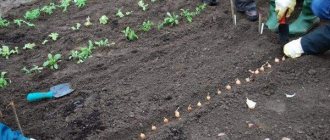Many novice summer residents are afraid to plant grapes on their plot. And in vain: planting and growing delicious berries will not cause any trouble if you follow the detailed step-by-step guide. The grape takes root in the Moscow region and Krasnodar region, the Volga region and Tatarstan, the Urals and Siberia.
How to plant a grapevine correctly and what recommendations to follow when planting seedlings and cuttings, we will consider in the article.
Planting grapes in spring
Grapes are planted both by cuttings and seedlings . After planting in the spring, the pace of development accelerates. The heat-loving plant gains strength over the summer, strengthens its immune system and prepares for winter. That is why spring planting is preferable to autumn planting, when the first frosts immediately set in and snow falls. Most grape varieties do not tolerate cold weather.
The disadvantage of spring planting is that insect pests and pathogens wake up after winter, so the young plant needs careful care. Summer residents carry out preventive and protective measures, spraying grapes with chemicals and folk remedies. For spring planting, seedlings are purchased in the fall and stored in the basement all winter. During this time, they may become weak or get sick.
Autumn planting of cuttings
Not all novice gardeners know how to properly plant grapes in the fall. Cuttings are harvested in October, and in more northern regions even earlier - at the end of September.
Smooth central sections of shoots no older than two years are suitable for cutting. It should feel firm to the touch. To cut a shoot, you need sharp garden shears - the cut should be even and smooth.
On cuttings 20 cm long and 5-10 mm thick, 2 to 4 live buds are left. They are rooted in moist soil at a distance of 15 cm between them, after planting they are shed abundantly with water. To protect against frost, a polyethylene film is stretched over the plants at a height of 35 cm, secured to supports. The protection is removed in the spring, after the frosts end and warm weather sets in.
When to plant grapes in spring
Cuttings and seedlings with a closed root system are planted in late spring - early summer , with an open one - at the end of April or early May. When choosing a date, it is important to pay attention to weather conditions and temperature. If it is raining outside or strong winds are blowing, the air temperature does not rise above +5°C, planting is postponed. The air should warm up to +15°C, and the ground - to +10°C.
Favorable days according to the lunar calendar
Using the lunar calendar, gardeners choose those days when planting grapes in open ground will be more successful. It is generally accepted that if you plant a plant on certain dates, it will get sick less and bear fruit better.
The choice of date depends on the rising and waning moon . In 2022, April 30 or May 29 are chosen for planting grapes. Unsuitable dates: May 7, 8, 12, 13, 20, 21.
Attention! Even if the lunar calendar says that April 30 and May 29 are suitable for planting, it is important to pay attention to weather conditions. Air and soil temperatures are the main criteria when choosing a period.
Pros and cons of spring planting seedlings
The period of planting grapevines in open ground should be understood as the time when the risk of night frosts is minimized, and the average daily temperature reaches +12-15 degrees. Such conditions allow us to count on the following points and factors:
- The grape bush will gain the necessary strength to go into winter, its root system will develop and will be able to not only provide it with nutrients, but will also ensure the first harvest the following year.
- In the spring there is time and it is easier to grow a viable seedling from a shank. If all measures are followed, developed material for planting can be obtained from the cuttings after storage.
- Warmth and a sufficient amount of moisture allow you to better prepare the place for planting and prepare materials for fertilizing and mulching.
- It is more profitable to grow varieties during spring planting - in the second year the plant begins to bear fruit, and in the third year it is able to produce a full harvest. When planted in autumn, the bushes begin to bear fruit with a delay of at least 1 year.
- It is also better to plant a bush in the spring because it is less at risk of dying from frost; fungal diseases are practically not found on such bushes.
Attention! For planting in the spring, viable seedlings are prepared and stored in the basement, which significantly increases the survival rate of plants.
In addition to the positive aspects, you need to be prepared for unfavorable moments:
- When the air temperature rises sharply in the spring, as has been observed in the last few years, a lack of moisture may occur and additional watering will be required.
- Planting grapes in the spring will require additional mulching of the soil and the application of organic and mineral fertilizers in large quantities.
- When purchasing seedlings at the market or at a garden center, there is a high probability of purchasing diseased or frost-damaged plants.
- When planting plants with green leaves, they become the object of attention of animals and insects, so you will have to carefully monitor the shoots and provide protection from uninvited guests.
Choosing a landing site
Grapes do not tolerate shade, so the plant is planted in the sunniest and well-lit places . There should be no tall buildings, fences or other structures nearby, otherwise they will block the sun. It is also important to exclude the presence of roads near the bush, as dust will settle on the fruits. It is recommended to place the plant in windless and dry places, away from groundwater. If the garden has a sunny hilly area, then the grapes are placed on it.
The soil must be loose and nutritious, otherwise the plant develops poorly . A suitable option is crumbly chernozem and purchased soil mixed with sand, rotted organic matter, and mineral components. Sandy or clayey soils are not suitable. They do not retain moisture and do not allow air to pass through well. Soil acidity should be moderate - from 4 to 8 pH. Excessive acidity leads to the death of the plant.
The best land
The correct choice of soil when planning a vineyard is the key to high yields, plant health and the success of the entire garden.
The basic requirements for soils are lightness, looseness and saturation with nutrients. The acidity of the soil should be in the range from 4.0 pH to 8.0 pH.
Based on this, grapes are best planted on clay, chernozem and sandy soils.
Chernozem
Pros:
- The soil is saturated with nutrients and requires virtually no fertilizer.
- Loose.
- Not prone to severe freezing.
The only downside is the tendency to compact and form a dense crust.
The peculiarities of planting grapes in black soil are the obligatory pipe for irrigation and the fact that large fractions should be added to the compost bed: stones, gravel, scrap and broken bricks.
Sand
Pros:
- The soil is loose and breathable.
- Waterproof.
- Does not form a crust.
- Easy to process.
Minuses:
- Low organic content.
- High degree of freezing, requires reclamation and application of manure, mulching.
Planting grapes in sand requires the creation of a thickened fertile cushion. A drainage pad and installation of a pipe for irrigation are optional.
Clay
Pros: The soil is dense and retains nutrients well.
Minuses:
- Requires the introduction of a large amount of organic matter.
- Cakes quickly at high temperatures, mulching.
- Waterproof, loosening required.
The main features of planting grapes in clay are a drainage bed made of gravel, a mandatory irrigation pipe and a compost bed with the addition of mineral fertilizers.
Preparation of planting material
Grapes are planted by cuttings, seedlings or vines. Cuttings are prepared in February or March . They are inspected, dry and damaged specimens are thrown away. To check the viability of the cutting, it is squeezed - moisture appears on healthy stems. The cut has a greenish tint. The remaining cuttings are soaked in water for 2 days, then placed in growth stimulants for a day: “Athlet”, “Krezacin” or “Kornevin”. They strengthen the plant’s immunity, increase its cold resistance, and improve the taste of future fruits.
When choosing seedlings, pay attention to the roots . There should be at least 4 of them - the more, the better the root system develops. A healthy seedling has large, long and elastic roots. The cut should be moist and white. Thin seedlings with dry and limp roots are not suitable for growing. This indicates that the plant is sick and will die after planting in open ground. The recommended length of a seedling is 30-40 cm. Sometimes 2- or 3-year-old seedlings already have 1-2 vines. If they are large, they will quickly take root and immediately produce several healthy shoots. The diameter of the vine must be at least 3 mm.
If the vine is immediately used for planting, it is treated with a 3% solution of ferrous sulfate. For preparation, 1 liter of water and 30 g of substance are required. The vine should not be too long, as the risk of infection by microbes and fungi increases. It is recommended to pay attention to its elasticity and the absence of cracks and stains.
Soil preparation
The soil for spring planting is prepared in the fall . In a southern and sunny place, dig a planting hole 80 cm deep and 70-90 cm in diameter. To make the soil breathable, a 10 cm drainage layer of broken brick or stone is laid at the bottom of the hole. Before winter, the pit is fertilized with a nutrient mixture - 1 kg of dry wood ash, 800 g of superphosphate, 1 kg of humus. Then water generously with warm water. In the spring, before planting, the soil is dug up to 60-80 cm.
Attention! If summer residents do not have time to prepare a hole in the fall, then in the spring they dig trenches measuring 65x65 cm for the grapes. This is done 4-8 weeks before planting. The bottom of the pit is made drainage, and the soil is fertilized with rotted manure or compost.
Soil preparation and fertilization
As mentioned above, in the fall the soil is planted with the addition of fertilizers, due to which the earth is enriched with oxygen and minerals. In spring, when the soil temperature is +10 degrees, you need to prepare a place for young grape seedlings. To fertilize the soil, you can use superphosphate fertilizers for grapes ; they contain all the microelements the seedling needs.
Compost pit
Fermented manure, which needs to be filled with water and mixed with soil, is also perfect. Under no circumstances should grape roots come into contact with pure manure and fertilizers, otherwise they will simply “burn”!
Mineral and organic fertilizers must be added to the hole; in addition to them, the young plant also requires potassium sulfate. It is added manually 100-200 grams to each well. Thanks to this, it will be easier for the young seedling to settle into a new place and survive heat and cold. An excellent organic fertilizer is peat, which is usually mixed with sawdust or humus.
How to plant grapes in spring - step-by-step instructions
The planting procedure will not take much time; the main thing is to choose calm and cloudy weather and prepare planting material.
How to plant grape seedlings in spring step by step:
- Insert a plastic tube with a diameter of about 5 cm into the hole on the side - it will later be used to water the plant.
- Add soil to the hole so that 50 cm remains to the top. Summer residents use garden or ready-made store-bought soil “Universal” or “Krepysh”. It contains vitamins and minerals for plants and is disinfected in advance.
- Water the pit with settled water heated in the sun. Wait until it is completely absorbed.
- Remove the grapes from the pot or container. Carefully straighten the roots of the seedling and place it in the hole. Cover it to the brim with dry soil.
Planting with cuttings is similar to planting with seedlings . It is only important to pay attention to the location of the cuttings - they are placed at an angle, vertically or in an arc.
Planting scheme, what to plant nearby
When determining a planting scheme, gardeners pay attention to the variety , plant height, and size of the vines. A distance of about 2 m is maintained between medium- and low-growing bushes, and 3 m between tall bushes. The width of row spacing is from 1.5 to 2 m. Grape bushes should not be planted too close to each other - in this case, the plant creates a shadow and prevents the growing plant next to it from developing bush. Also, when the planting is dense, the grapes are poorly ventilated, which has a bad effect on the taste and appearance of the fruit. The bushes are located from north to south.
carrots, sorrel, peas, beans, strawberries, and cucumbers next to Unsuitable neighbors for the crop are parsley, gooseberries, potatoes, celery. It is also not recommended to plant grapes next to tall apple and pear trees - fruit trees shade the grapes, and they suffer from a lack of sunlight. Fruit trees can “steal” grape nutrients from the soil.
Nuances of planting depending on the growing region
In the middle zone and northern regions, summer residents resort to a trick : on the northern side of the garden bed, they install a screen of boards along the entire length and paint it green. The height of the structure is from 80 to 100 cm. The screen does not allow cold wind to pass through, which is especially important in the Urals, Siberia, and the middle zone. It heats up and creates favorable growing conditions. The seedlings are placed at a distance of 40 cm. Such a screen is indispensable in cool summers.
Attention! To ensure that the soil in the root system area warms up faster, the ground under the seedlings is covered with black film. This will prevent weeds from appearing and protect the soil from drying out. Another proven method will help preserve heat - placing stones around the seedling. They heat up and transfer heat to the plant and soil.
Depending on the type of grape
There are table and industrial grapes . The first is suitable for fresh consumption, the second is suitable for processing and preparing wine, juice, and champagne.
For table varieties, the appearance of the berries is important - color and size . Therefore, it is important before and after planting to pay attention to organic and mineral fertilizers, on which the development of fruits depends. Such grapes are sensitive to the lack of sun, so planting them in the shade is unacceptable. Also, after planting, the plant is sprayed with a solution of Bordeaux mixture so that insects and diseases do not affect the bunches.
In technical varieties, taste plays a greater role than appearance . Technical grapes are smaller, the plants do not have dense foliage. When growing, follow the recommendations for the neighborhood and location of the bushes. Thickened planting will lead to a decrease in yield.
Further care
Grapes love water, but cannot tolerate its excess . Before watering the plant, check the soil moisture level. Dip your finger into the soil and see how deeply the soil has dried out. For irrigation, use a tube installed next to the seedling during planting, or place a garden hose under the bush.
For watering, choose the morning - the optimal time, the grapes have woken up and are ready to be hydrated . If watered during the day, then in cloudy weather. Otherwise, the sun will cause the moisture to evaporate before it has time to penetrate the soil. Once a week, instead of watering, sprinkling is used - the procedure activates the process of photosynthesis and removes dust from young leaves.
Attention! To prevent water from evaporating, the vineyard is mulched. Sawdust, purified river sand, leaves, and hay are used. Mulch slows down the development of weeds and protects against aphids, mole crickets, and sawflies.
In the first year of life, ready-made preparations are chosen for feeding , for example, “Gumi-Plus” or “Biovit”. They contain nitrogen and potassium in the amount necessary for a young plant. Before and after fertilizing, the grapes are watered. No fertilizer is applied to dry soil. The next procedure is carried out no earlier than a month later.
Tillage
Grapes are a demanding plant to care for. To obtain stable yields, the vineyard should be regularly loosened, watered and fertilized to improve the survival rate of the cuttings.
Plowing
The future harvest begins in the fall, so autumn processing is extremely important. It is carried out immediately after harvest. During this period, deep digging is carried out and the soil layer is turned over between rows; collection of fallen leaves is mandatory, since the main pests and pathogens overwinter under the leaves.
In spring and summer it is also necessary to treat the soil against weeds. Additional loosening will also reduce moisture loss and provide additional oxygen and nutrition to plant roots.
It should be noted that the plowing depth in the rows of the vineyard should be up to 30 cm, directly around the plants - 10-12 cm, so as not to injure young roots or touch large roots. The most convenient tool for this type of work is a pitchfork.
Note! Weeds not only choke young vines and take moisture and nutrients from the soil. Frequent thickets create a favorable microclimate for the development of a large number of vineyard diseases, and also shelter insect pests.
Summer loosening is carried out with a rake or hoe. The main task is to prevent the appearance of a dense crust on the surface of the earth. The amount of loosening depends on weather conditions.
It is possible to grass the soil in the vineyard by sowing the rows with herbs: mustard, alfalfa and others. A huge advantage of this method is the increase in soil fertility, but the disadvantage is the need to periodically mow the grass.
Fertilizer application
Immediately after plowing, organic or mineral fertilizers are applied to the plants. Mulching the soil in tree trunk circles is effective.
Manure
to the vineyard on poor soils. Required parameters:
- The material must be rotted when introduced into the circles around the trunk.
- If there is no rotted manure, then you can infuse the slurry for two weeks. For 1 part manure you need 2 parts water. After fermentation, the solution is diluted in a ratio of 1:6 and poured to the roots of the vine.
- Volume 4-6 kg per 1 sq.m.
- Manure, like other organic matter, is applied strictly before flowering begins.
- On chernozems, the application of manure is not necessary.
Mulch
It is both a way to maintain the soil in the required condition in terms of moisture and looseness, and a universal fertilizer when planting in both spring and autumn. Organic mulch, consisting of straw, hay, sawdust, pine needles, with a layer thickness of 5-7 cm, completely prevents the growth of weeds and loss of moisture from the soil. At the same time, in the fall it can be easily dug up and over the winter it will rot and release a huge amount of nutrients for the vineyard.
Peat compost
Peat compost
Composts are a universal fertilizer for the vineyard. They are made in advance from any plant residues: grass, fallen leaves, pine needles, household organic waste.
Compost heaps should be periodically moistened and turned over; specialized bacteria can be added for more active overheating.
Compost is applied under the grape plants in the spring in the area where the main roots occur. It is also an optimal fertilizer for planting young plants.
Bird droppings
This organic fertilizer must be applied exclusively in the form of a fermented solution. The infusion is prepared as follows: take 4 parts of water for 1 part of dry chicken manure and allow to ferment for 2 weeks. Then top up to a volume of 10 liters and pour under the grape bushes.
For 1 bush it requires up to one liter of solution. This fertilizing covers the vineyard’s needs for potassium and nitrogen.
Pest treatment
The vineyard should be cultivated not only by the plants, but also by the soil. A huge number of insect pests, as well as pathogenic fungi and bacteria, overwinter in the soil.
Remember , it is always easier to prevent a disease than to deal with the consequences of infection.
Pest treatments are carried out several times a season, and begin in early spring, at the very beginning of bud opening.
Spring
For spring treatment, take a 1% solution of iron sulfate. Before processing, the covering material is removed from the vine, the remains of last year's foliage are collected, row-spacing and deep loosening under the plants are carried out, and dead branches are removed.
Treatment with iron sulfate increases resistance to fungal diseases, prevents the appearance of mosses and lichens on the vine, and also slows down the opening of buds, which will protect them from damage by late frosts.
After 10 days, it is recommended to carry out specialized treatment of the vineyard and soil with fungicides - antifungal drugs.
Summer
Summer soil treatment against pests includes the application of sulfur preparations or spraying the soil and vines with sulfur-containing preparations. Sulfur successfully increases the vineyard's resistance to powdery mildew.
In summer, soil treatment in the vineyard with karbofos is necessary. Plantings are a very convenient place for colonies of ants to live, and therefore for the breeding of aphids. Periodic spraying of the soil with karbofos reduces the severity of the problem to almost zero.
Treatment of grapes from pests
Autumn
The main tillage of the soil in the vineyard is carried out in the fall, along with plowing and preparation for winter. For this, a 3-5% solution of copper and iron sulfate is used. These drugs suppress the development of fungal diseases by destroying spores in the soil.
Tips and tricks
To ensure that the grapes grow healthy and bear fruit consistently, after planting they are sprayed with a solution of wood ash - 3 tbsp. l. for 1 liter of water. The components are mixed and infused for a week. Afterwards, the vineyard is sprayed 1-2 times a month. The solution protects against diseases and pests, disinfects the plant, and replenishes the lack of vitamins and microelements.
In the first year, summer residents regularly inspect the bushes and remove the resulting stepsons . They also keep the beds clean: weeds and fallen leaves are regularly removed. This reduces the risk of developing diseases.
Mistakes to Avoid
If the grape shoots dry out or become covered with plaque, and the root system does not develop, then mistakes were made :
- premature landing;
- purchasing seedlings from an unverified place;
- acidic clay soil;
- improper storage of seedlings;
- failure to maintain proximity to other plants;
- selection of the northern site;
- groundwater nearby;
- excess or lack of fertilizers.
Deciding on a place
The area allocated for the vineyard is dug up at least six months before the intended planting. It must be completely freed from grass, dug up and the layer turned over.
Important! Groundwater should be located no closer than 2 meters from the surface. If this does not meet the requirement, then it is necessary to consider a drainage system for the vineyard site.
Acidity is determined. In case of high acidity, liming of the entire area is carried out.
